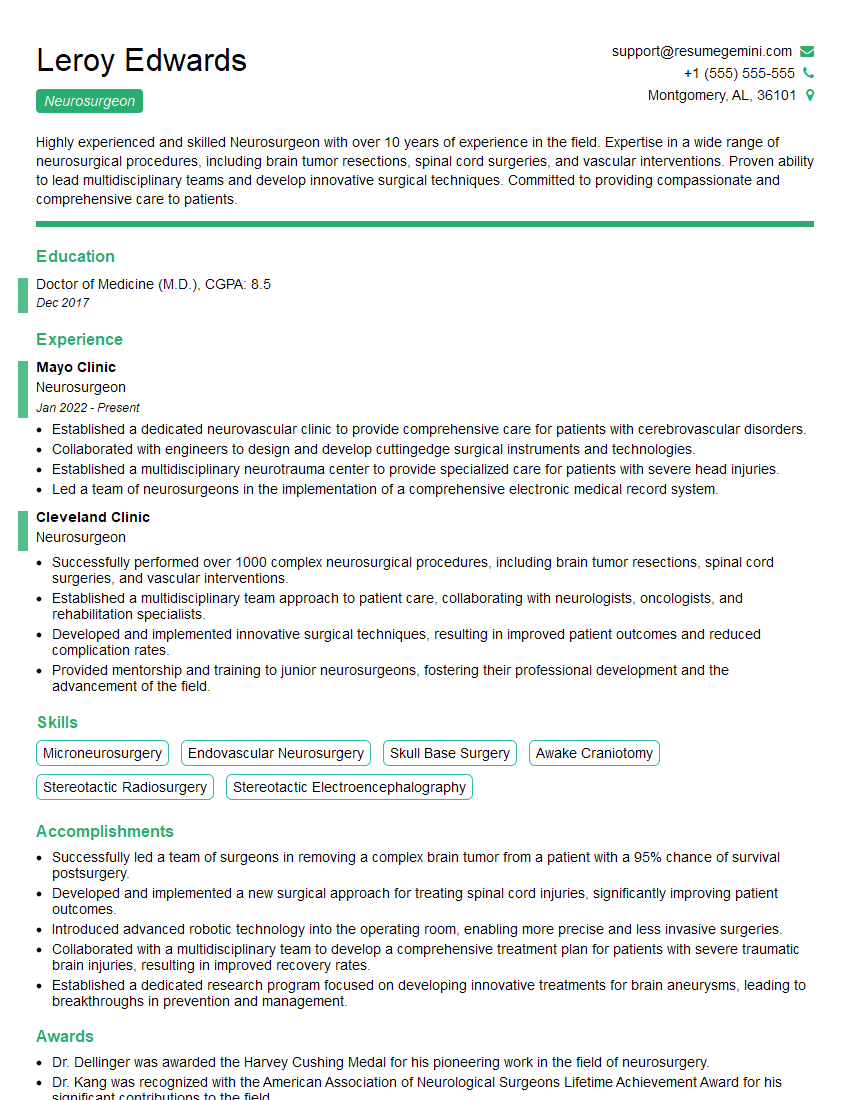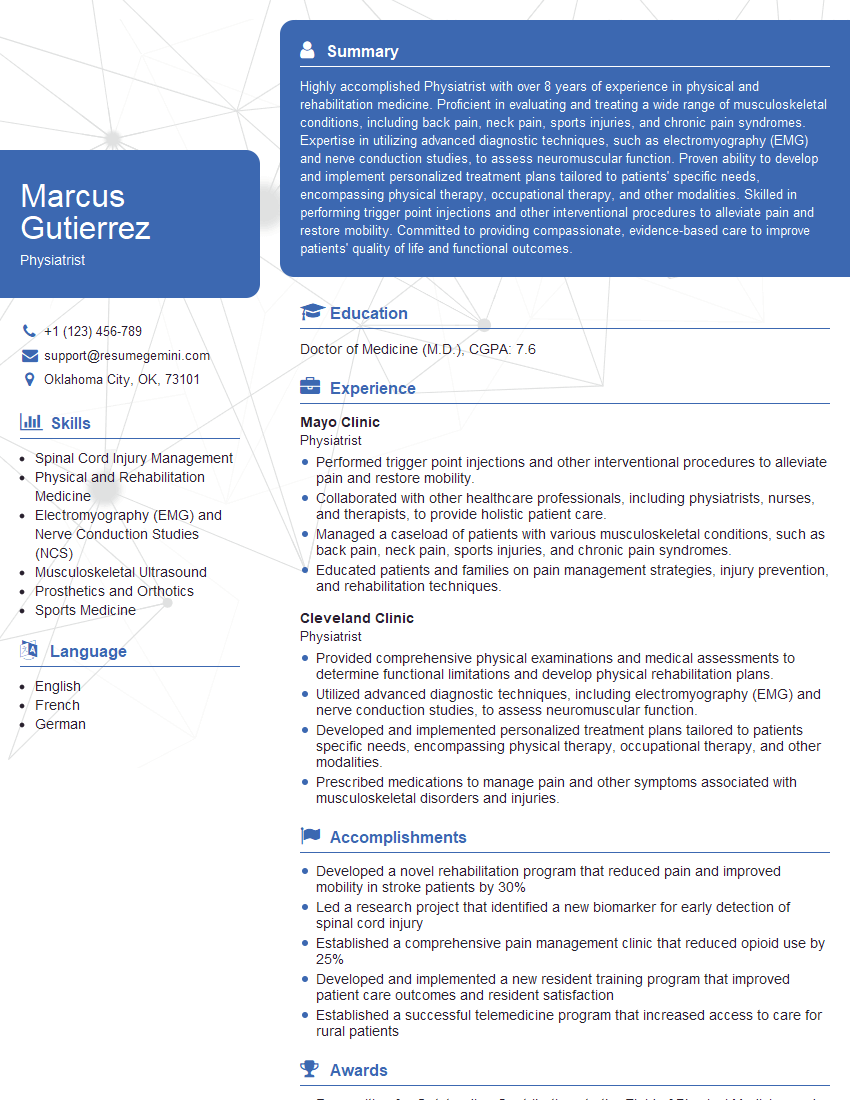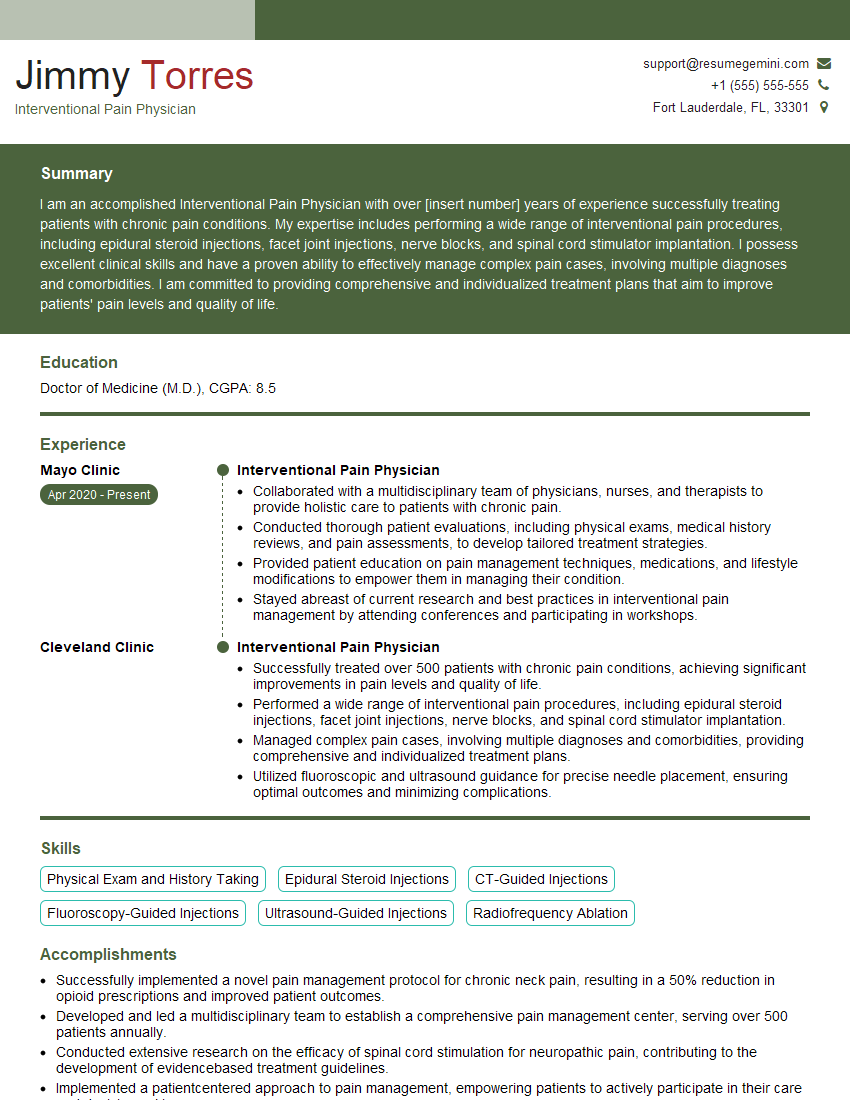The thought of an interview can be nerve-wracking, but the right preparation can make all the difference. Explore this comprehensive guide to Epidural Injections interview questions and gain the confidence you need to showcase your abilities and secure the role.
Questions Asked in Epidural Injections Interview
Q 1. Describe the different types of epidural injections.
Epidural injections deliver medication into the epidural space, the area surrounding the dura mater, the outermost layer of the protective membranes covering the spinal cord. There are several types, primarily categorized by the medication injected and the targeted area.
- Steroid Epidural Injections: These are the most common type, using corticosteroids to reduce inflammation and pain in the spine. They are often used for conditions like sciatica, spinal stenosis, and herniated discs.
- Local Anesthetic Epidural Injections: These injections use local anesthetics to provide pain relief, often for post-surgical pain management or labor analgesia. They temporarily numb the area.
- Combination Epidural Injections: These often combine corticosteroids and local anesthetics to provide both immediate pain relief (from the local anesthetic) and longer-lasting anti-inflammatory effects (from the steroid).
- Caudal Epidural Injections: These are administered through the sacral hiatus, a space at the base of the spine, often used for pain management in children or for targeting lower back pain.
The choice of injection type depends heavily on the patient’s specific condition, pain location, and response to previous treatments. For instance, a patient with acute sciatica might benefit from a combination injection, while chronic back pain might be addressed with a steroid-only injection.
Q 2. Explain the indications and contraindications for epidural steroid injections.
Indications for epidural steroid injections (ESIs) include radiculopathy (nerve root pain) caused by conditions like disc herniation, spinal stenosis, and facet joint syndrome. They’re also used for inflammatory conditions like ankylosing spondylitis. ESIs offer a targeted approach, aiming to reduce inflammation directly at the source of pain.
However, contraindications are important to consider. These include active infections, bleeding disorders (because of the risk of bleeding into the epidural space), a history of epidural hematoma, untreated osteoporosis, and local skin infection at the injection site. Furthermore, patients with allergy to corticosteroids should not receive an ESI. A thorough medical history and physical exam are crucial to determine suitability.
For example, a patient with a history of recurrent epidural hematomas would be unsuitable for an ESI because of the high risk of a life-threatening complication.
Q 3. What are the potential complications associated with epidural injections?
While generally safe, epidural injections carry potential complications. These range from minor to severe.
- Post-dural puncture headache (PDPH): This is a common complication, caused by leakage of cerebrospinal fluid following the puncture. It presents as a severe headache worsened by sitting or standing and relieved by lying down.
- Infection: Infection at the injection site or, rarely, more serious spinal infections, are potential, albeit infrequent, complications requiring prompt medical attention.
- Bleeding (hematoma): Although rare, bleeding into the epidural space is a serious complication, potentially causing nerve compression or spinal cord injury.
- Nerve damage: Direct injury to a nerve during injection is possible, though uncommon with proper technique. It can result in temporary or permanent neurological deficits.
- Allergic reactions: Reactions to the injected medication, such as corticosteroids, can occur, ranging from mild skin irritation to severe anaphylaxis.
These complications highlight the importance of meticulous technique, careful patient selection, and post-procedure monitoring. For instance, careful asepsis is essential to minimise the risk of infection. Furthermore, a thorough patient history including medication allergies is crucial.
Q 4. How do you select the appropriate needle size and approach for an epidural injection?
Needle size and approach are chosen based on factors such as the patient’s anatomy, the target area, and the type of injection. For example, a smaller needle (e.g., 22-25 gauge) might be preferred in patients with known or suspected spinal stenosis to minimize trauma.
Approaches include:
- Midline approach: The needle is inserted in the midline of the back, aiming for the epidural space.
- Paramedian approach: The needle is inserted slightly off-center to avoid potential bony structures.
- Interlaminar approach: The needle is inserted between the laminae of adjacent vertebrae.
The choice of approach often depends on the specific location of the pain and the clinician’s experience and judgment. Loss of resistance or fluoroscopic confirmation is typically used to ensure correct needle placement within the epidural space.
For instance, in a patient with severe spinal stenosis, a smaller gauge needle and a paramedian approach might be selected to minimise potential trauma.
Q 5. Describe your technique for performing a caudal epidural injection.
A caudal epidural injection is administered through the sacral hiatus, a gap at the base of the spine. The procedure typically involves:
- Positioning: The patient is placed in the prone position with a pillow under their hips to enhance sacral curvature.
- Palpation: The sacral hiatus is carefully palpated to locate the injection site.
- Skin preparation and draping: The area is thoroughly cleaned and draped to maintain sterility.
- Local anesthetic infiltration: Local anesthetic is injected into the skin and subcutaneous tissue to numb the area.
- Needle insertion: A smaller gauge needle is inserted through the sacral hiatus, aiming toward the caudal epidural space.
- Aspiration: Aspiration is performed to confirm the needle is not within a blood vessel.
- Medication injection: The appropriate medication (e.g., local anesthetic, corticosteroid) is slowly injected.
- Needle withdrawal: The needle is slowly withdrawn.
- Dressing application: A sterile dressing is applied to the injection site.
Post-procedure monitoring for any adverse reactions is essential. Caudal epidural injections are often used in children for post-surgical pain management or other conditions, making careful technique and appropriate medication selection paramount.
Q 6. How do you manage a patient experiencing a post-procedure headache after an epidural injection?
A post-procedure headache after an epidural injection, often a PDPH, can be quite distressing. Management focuses on supportive care and sometimes more interventional measures.
Initial management includes:
- Bed rest: Encouraging the patient to remain in bed with their head elevated.
- Hydration: Increased fluid intake to help replenish cerebrospinal fluid.
- Pain medication: Analgesics, such as acetaminophen or NSAIDs, may help manage pain. Sometimes stronger analgesics may be required.
- Caffeine: Caffeine has shown some benefit in reducing the severity of PDPH.
If conservative measures fail, more interventional strategies might be considered, such as an epidural blood patch. This involves injecting a small amount of the patient’s own blood into the epidural space to seal the dural leak. In less severe cases, the headache often resolves spontaneously within a few days.
For example, a patient experiencing severe PDPH despite conservative measures might require an epidural blood patch to alleviate the headache.
Q 7. What are the imaging modalities used to guide epidural injections?
Imaging modalities play a crucial role in guiding epidural injections, especially to ensure accurate needle placement and minimize the risk of complications.
- Fluoroscopy: This is the most commonly used imaging technique. It provides real-time X-ray images, allowing the physician to visualize the needle’s progression and confirm its location within the epidural space.
- Computed Tomography (CT): CT scans provide detailed cross-sectional images of the spine. They are sometimes used for pre-procedural planning, particularly in complex cases.
- Ultrasound: Ultrasound is occasionally used, particularly for caudal epidural injections, providing real-time images of the anatomy without the use of ionizing radiation.
The choice of imaging modality depends on several factors, including the patient’s specific anatomy, the target area, and the availability of resources. Fluoroscopy is generally preferred for its real-time guidance and relatively lower cost, while CT scans offer superior anatomical detail.
For example, in a patient with significant spinal deformities, a CT scan might be used pre-procedure to plan the injection, while fluoroscopy is used during the actual procedure for real-time guidance.
Q 8. Explain the difference between a transforaminal epidural injection and a caudal epidural injection.
The key difference between transforaminal and caudal epidural injections lies in their approach and target area. Think of the spine as a highway, with different exits leading to various destinations. A transforaminal epidural injection (TEI) targets a specific nerve root at a particular level of the spine by accessing it through the intervertebral foramen – the ‘exit ramp’ between two vertebrae. This is like precisely addressing a specific pain generator. The needle is advanced under fluoroscopic guidance through the foramen, aiming to deposit medication near the nerve root. A caudal epidural injection (CEI), on the other hand, accesses the epidural space through the sacral hiatus – a ‘service road’ at the very bottom of the spine. Medication is then spread more diffusely throughout the lower lumbar and sacral regions, acting like a blanket of pain relief over a larger area. CEIs are commonly used for conditions affecting the lower back and legs.
- TEI: Precise targeting, individual nerve root, used for radiculopathy.
- CEI: Diffuse coverage, lower lumbar & sacral, used for generalized pain.
Q 9. How do you assess the success of an epidural injection?
Assessing the success of an epidural injection is multifaceted and relies on both objective and subjective measures. We look for a reduction in the patient’s reported pain levels, improved functional mobility, and any decrease in neurologic symptoms like numbness or weakness. For example, if a patient reports a 50% decrease in pain intensity on a 0-10 scale, coupled with an improvement in their ability to walk without assistance, we consider this a positive response. Objective measures may include changes in range of motion, muscle strength tests, or improvements in gait analysis. However, it’s important to remember that the results vary depending on the condition being treated. Some patients may show immediate improvement, while others might require a series of injections or alternative treatment approaches.
Q 10. Describe the role of fluoroscopy in performing epidural injections.
Fluoroscopy plays a crucial role in ensuring accurate and safe placement of the needle during epidural injections. It’s like having an X-ray movie that allows us to visualize the needle’s progression in real-time. This is particularly important with TEIs due to their targeted nature. Fluoroscopy helps us to identify the precise location of the intervertebral foramen or the sacral hiatus, avoid critical structures like blood vessels and nerves, and verify the correct position of the medication within the epidural space. We use fluoroscopy to confirm that the injection is localized and to minimize the risk of complications. Without fluoroscopy, the procedure is significantly more risky and less likely to be effective.
Q 11. What are the common adverse effects of corticosteroids used in epidural injections?
Corticosteroids, commonly included in epidural injections, provide anti-inflammatory effects, but they can also have adverse effects. These are usually transient, but awareness is crucial. Some common adverse effects include:
- Increased blood sugar levels: This can be particularly problematic for patients with diabetes.
- Fluid retention: Leading to swelling in the extremities and potential weight gain.
- Mood changes: Such as irritability, anxiety, or insomnia.
- Gastrointestinal upset: Including nausea, vomiting, or heartburn.
- Local reactions: Such as pain or redness at the injection site.
- Rarely: More serious systemic effects like infection or nerve damage.
We carefully consider the risks and benefits for each patient, and sometimes prescribe additional medication, like a prophylactic PPI, to reduce the chances of some of these side effects.
Q 12. How do you manage a patient who experiences an allergic reaction to local anesthetic during an epidural injection?
Managing an allergic reaction to local anesthetic during an epidural injection requires immediate action. The reaction can range from mild (itching, rash) to severe (anaphylaxis). The first step is to immediately stop the injection. Then, we follow established protocols for managing anaphylaxis, which usually include:
- Administering oxygen: To ensure adequate oxygen supply.
- Using epinephrine: This is a crucial medication to counteract the effects of the allergic reaction.
- Administering intravenous fluids: To maintain blood pressure.
- Monitoring vital signs: Closely watching heart rate, blood pressure, and oxygen saturation levels.
- Transfer to a hospital: For further monitoring and treatment if needed.
Having a well-rehearsed emergency plan in place is essential for safely handling these situations.
Q 13. Describe your approach to patient selection for epidural injections.
Patient selection for epidural injections is crucial. We carefully review the patient’s medical history, physical examination, and imaging studies (X-rays, MRI, CT scans) to determine if an epidural injection is appropriate. Ideal candidates typically have specific conditions such as radiculopathy (nerve root compression), spinal stenosis (narrowing of the spinal canal), or facet joint syndrome (pain stemming from the small joints of the spine). We would carefully consider contraindications such as active infection, bleeding disorders, or allergy to the injection components. Furthermore, we assess the patient’s understanding of the procedure, their expectations, and whether they are capable of following post-procedure instructions.
Q 14. How do you counsel patients about the risks and benefits of epidural injections?
Counseling patients about the risks and benefits of epidural injections is a critical part of the process. I start by explaining the procedure in simple terms, using analogies to make it easy to understand. I clearly outline the potential benefits, such as pain relief and improved function, but also candidly discuss the risks, which include bleeding, infection, nerve damage, and the potential side effects of corticosteroids. I also discuss the potential for the injection to not provide any relief. We often compare it to a diagnostic test that, while aiming for improvement, isn’t guaranteed to resolve the condition completely. This informed consent process empowers patients to make an educated decision about their care, based on their individual circumstances and risk tolerance. This includes open discussion about alternative treatment options, too.
Q 15. What are the alternatives to epidural injections for managing back pain?
Before considering an epidural injection for back pain, we explore a range of alternatives. These options are tailored to the individual’s specific condition and preferences, always prioritizing the least invasive approach. Conservative management often takes precedence.
- Physical Therapy: This is a cornerstone of treatment, focusing on strengthening core muscles, improving posture, and increasing flexibility. We might recommend specific exercises targeting the affected area. For instance, a patient with lower back pain may benefit from core strengthening exercises like planks and bridges.
- Medication: Over-the-counter pain relievers like ibuprofen or acetaminophen can be effective for mild to moderate pain. For more severe pain, we might prescribe stronger medications such as nonsteroidal anti-inflammatory drugs (NSAIDs) or muscle relaxants.
- Lifestyle Modifications: Changes like losing weight, improving ergonomics at work, and engaging in regular low-impact exercise can significantly impact back pain. This might involve recommending an ergonomic chair or suggesting modifications to their sleeping posture.
- Alternative Therapies: Depending on the patient, we might explore options like acupuncture, chiropractic care, or massage therapy. The efficacy of these varies greatly, but they can be helpful for some individuals.
- Other Injections: Facet joint injections or sacroiliac joint injections can target specific areas of pain, offering a less invasive alternative to epidural steroid injections. For example, facet injections can alleviate pain stemming from the facet joints in the spine.
The choice of alternative depends on a thorough assessment of the patient’s medical history, physical examination findings, and imaging studies. We work collaboratively with the patient to develop a treatment plan that best addresses their needs.
Career Expert Tips:
- Ace those interviews! Prepare effectively by reviewing the Top 50 Most Common Interview Questions on ResumeGemini.
- Navigate your job search with confidence! Explore a wide range of Career Tips on ResumeGemini. Learn about common challenges and recommendations to overcome them.
- Craft the perfect resume! Master the Art of Resume Writing with ResumeGemini’s guide. Showcase your unique qualifications and achievements effectively.
- Don’t miss out on holiday savings! Build your dream resume with ResumeGemini’s ATS optimized templates.
Q 16. How do you determine the appropriate dosage of medication for an epidural injection?
Determining the appropriate dosage for an epidural injection is a crucial aspect of patient safety and efficacy. It’s not a one-size-fits-all approach. The dosage is individualized based on several factors.
- Patient’s Weight and Size: Dosage is often calculated based on body weight to ensure the correct concentration of medication reaches the target area. A larger individual will generally require a slightly higher dosage than a smaller one.
- Type of Medication: Different medications have different potencies. For example, a corticosteroid like methylprednisolone has a different dosage range compared to local anesthetics such as bupivacaine or lidocaine.
- Patient’s Medical History: Pre-existing conditions, such as kidney or liver disease, can affect how the body processes medication and might require dosage adjustments. Patients with a history of steroid use will also require careful consideration of dosage.
- Severity of Pain and Condition: A patient with chronic, severe pain may require a higher dose compared to someone with acute, mild pain. The specific diagnosis, such as radiculopathy or spinal stenosis, influences the dosage decision.
- Previous Response to Treatment: If a patient has received epidural injections in the past, their response to previous dosages guides our decision-making process for subsequent injections.
We carefully review the patient’s chart and discuss the proposed dosage with them, addressing any concerns they have. Safety is our top priority.
Q 17. Describe your experience with different types of needles and catheters used in epidural injections.
My experience encompasses a range of needles and catheters used in epidural injections, each with its own characteristics and applications.
- Needles: We utilize various needle sizes, typically ranging from 18G to 27G. The choice depends on the patient’s anatomy, the injection site, and the physician’s preference. Thicker needles (smaller gauge numbers like 18G) are sometimes used for facilitating catheter placement, while thinner needles (larger gauge numbers like 27G) might be preferred for medication delivery when catheter placement isn’t necessary. I’ve personally found that the Tuohy needle is a common and reliable choice for its ease of use and reduced risk of spinal puncture.
- Catheters: Catheters allow for continuous or intermittent medication delivery and can be left in place for several days. Different catheter types include the standard epidural catheter and those designed specifically for smaller gauge needles. The length and material of the catheter are also important considerations, to minimize the risk of malposition or displacement.
The selection of the needle and catheter is based on a careful assessment of the individual patient’s needs and the overall procedure plan, always with safety and patient comfort at the forefront.
Q 18. What is your understanding of the anatomy relevant to epidural injections?
A thorough understanding of the relevant anatomy is paramount for safe and effective epidural injections. The procedure involves navigating the complex structures of the spine.
- Vertebral Column: This includes the individual vertebrae, intervertebral discs, and spinal cord. Precise identification of these structures is essential to avoid accidental puncture.
- Epidural Space: This is the space between the dura mater (a protective layer surrounding the spinal cord) and the periosteum of the vertebral bone. This is the target area for the injection.
- Spinal Cord and Nerve Roots: Careful avoidance of these structures is crucial to prevent neurological damage. Anatomical variations exist and must be considered during the procedure. It’s like navigating a very precise route through a busy city – one wrong turn, and you’re in trouble.
- Ligaments and Muscles: The surrounding ligaments and muscles need to be considered when choosing the injection site and inserting the needle.
We routinely use anatomical landmarks and imaging guidance (discussed later) to accurately locate the epidural space and to avoid any complications. A clear mental picture of the spine’s architecture guides every step of the procedure.
Q 19. How do you handle unexpected complications during an epidural injection procedure?
Unexpected complications during an epidural injection, while rare, require immediate and decisive action. Preparation and a well-defined protocol are key.
- Spinal Headache: If this occurs, it often indicates a dural puncture. Management involves bed rest, hydration, and in some cases, a blood patch.
- Infection: Strict aseptic technique is used to minimize the risk. If infection develops, treatment involves antibiotics and close monitoring.
- Bleeding: Patients with bleeding disorders are carefully screened. Should bleeding occur, pressure may be applied. In severe cases, surgical intervention might be necessary.
- Nerve Damage: This is a rare but serious complication. Management focuses on alleviating symptoms and possibly referral to a neurologist.
- Incorrect Placement: If the medication is not placed in the epidural space, it may not be effective. We use imaging guidance to reduce this risk.
Our protocols emphasize immediate assessment, appropriate treatment, and, if necessary, consultation with specialists. Patient safety is paramount, and transparency about any complications is essential.
Q 20. What are the specific legal and ethical considerations related to performing epidural injections?
Performing epidural injections carries significant legal and ethical responsibilities. We must adhere strictly to professional standards and regulations.
- Informed Consent: Patients must fully understand the procedure, its benefits, risks, and alternatives. This involves a detailed conversation clarifying all aspects of the intervention.
- Medical Record Documentation: Accurate and comprehensive documentation of the procedure, including the indication, dosage, and any complications, is mandatory for legal and medical reasons. Precise documentation helps avoid any ambiguity or uncertainty in case of any legal review.
- Adherence to Practice Standards: Following established guidelines and protocols is vital. This includes maintaining a sterile environment, using appropriate imaging techniques, and following recommended medication dosages. We always check that we’re complying with all relevant guidelines.
- Patient Confidentiality: Protecting patient privacy is paramount, adhering to HIPAA and other relevant regulations. Patient data is always handled with utmost discretion and security.
- Appropriate Referral: Understanding when to refer a patient to a specialist or other healthcare professional is essential. This ensures the patient receives the best possible care.
Ethical conduct is at the core of our practice. Maintaining the highest levels of integrity ensures patient trust and protects both the patient and the physician.
Q 21. Describe your experience with different types of imaging guidance for epidural injections.
Imaging guidance has significantly improved the safety and accuracy of epidural injections. I have extensive experience with various imaging modalities.
- Fluoroscopy: This technique uses real-time X-ray imaging to visualize the needle as it is advanced. It provides immediate feedback, ensuring accurate placement within the epidural space. This is a common method used in our practice.
- Ultrasound: Ultrasound guidance is non-ionizing, which reduces exposure to radiation compared to fluoroscopy. It offers a real-time visualization of anatomical structures and aids in needle placement, particularly useful when anatomical landmarks are difficult to palpate.
- Computed Tomography (CT): CT scans provide high-resolution images of the spine and can be used to plan the injection site before the procedure and verify needle placement afterward. While not real-time, it offers excellent anatomical detail.
The choice of imaging modality often depends on factors like patient anatomy, availability of equipment, and the clinician’s expertise. My experience allows me to effectively utilize these techniques to improve the safety and precision of the procedure and reduce the risk of complications.
Q 22. How do you maintain sterility during an epidural injection procedure?
Maintaining sterility during an epidural injection is paramount to prevent infection, a serious complication. We adhere to strict aseptic techniques throughout the procedure. This starts with thorough hand hygiene using an alcohol-based antiseptic solution for at least 30 seconds, followed by donning sterile gloves, gown, and mask. The patient’s skin at the injection site is prepped with a broad-spectrum antiseptic, such as chlorhexidine or povidone-iodine, using a circular motion from the center outwards to prevent contamination. The area is then draped with sterile drapes, creating a sterile field. All instruments and equipment used, including the needles, syringes, and catheters, are sterilized appropriately. We regularly inspect equipment for any damage or signs of contamination before use. Throughout the procedure, we maintain a sterile field, avoiding touching non-sterile surfaces or items.
Think of it like preparing a surgical field – every step is critical to eliminate any potential for infection. Even a small breach in sterility can have significant consequences.
Q 23. Describe your post-procedure care for patients who have undergone an epidural injection.
Post-procedure care focuses on patient safety and comfort, and monitoring for complications. Immediately following the injection, the patient is monitored for at least 30-60 minutes for any adverse reactions such as hypotension, respiratory depression, or neurological deficits. Vital signs, including blood pressure, heart rate, and respiratory rate, are closely observed. Neurological assessment, including motor and sensory function, is crucial to detect any signs of nerve injury. We educate patients on potential side effects such as bleeding at the injection site, headache, and back pain, and provide instructions on pain management using prescribed analgesics. Patients are advised to report any unusual symptoms immediately. We also provide detailed instructions on post-procedure activity restrictions, emphasizing the importance of rest and avoiding strenuous activities for a specific period following the injection. Finally, a follow-up appointment is scheduled to assess the effectiveness of the treatment and address any concerns. We emphasize the importance of hydration.
Q 24. How do you document the procedure and patient response after an epidural injection?
Documentation is a crucial aspect of patient care and legal protection. We meticulously document every step of the epidural injection procedure, ensuring accuracy and completeness. Our records include the patient’s demographics, medical history, and the indication for the procedure. We detail the type and amount of medication administered, the injection site, and the technique used. Intraoperative findings, including any difficulties encountered, and the patient’s response to the procedure are meticulously recorded. Post-procedure observations, including vital signs and neurological assessments, are also documented. The patient’s pain level, using a standardized pain scale (e.g., Numeric Rating Scale), is recorded before and after the injection. Finally, we document any instructions given to the patient, including medications prescribed and follow-up appointments scheduled. This detailed documentation helps in tracking the patient’s progress and ensures continuity of care.
We use electronic health records (EHRs) which allow for standardized templates and easy access to the patient’s complete medical history and procedure details.
Q 25. What is your experience with using nerve stimulators during epidural injections?
Nerve stimulators are invaluable tools in improving the accuracy and safety of epidural injections. They help identify the correct epidural space by providing sensory feedback. The stimulator is placed near the intended injection site, and a small electrical current is used to stimulate the nerves in the area. The patient reports the sensations experienced, which helps guide the placement of the needle. This ensures that the medication is delivered accurately into the epidural space, reducing the risk of complications such as accidental intravascular or intrathecal injection. For example, if the patient feels tingling in their leg during stimulation, it provides confirmation that the needle is in close proximity to the nerve roots, guiding us to appropriately position for injection. I have extensive experience using nerve stimulators in a variety of clinical settings and find them particularly helpful in challenging cases where anatomical landmarks are less defined.
Q 26. Explain your understanding of the pharmacodynamics and pharmacokinetics of medications used in epidural injections.
Understanding the pharmacodynamics and pharmacokinetics of medications used in epidural injections is vital for safe and effective administration. Pharmacodynamics refers to the effects of the drug on the body. In epidural injections, we commonly use local anesthetics (e.g., bupivacaine, lidocaine), corticosteroids (e.g., methylprednisolone, dexamethasone), and opioids (e.g., morphine, fentanyl). Local anesthetics block nerve conduction, providing analgesia and anesthesia. Corticosteroids reduce inflammation, while opioids provide additional pain relief. Pharmacokinetics describes how the body processes the drug, including its absorption, distribution, metabolism, and excretion. The rate of absorption and distribution of medications administered epidurally varies depending on the drug’s properties, the site of injection, and the patient’s individual characteristics. For instance, the onset of action and duration of effect of different local anesthetics can significantly differ. Understanding these pharmacokinetic parameters allows for appropriate medication selection and dosage, optimizing therapeutic efficacy while minimizing side effects.
For instance, we consider a patient’s renal and hepatic function when selecting and dosing medications to avoid accumulation and toxicity. We would carefully adjust dosages for patients with compromised organ function.
Q 27. Describe a challenging case involving an epidural injection and how you addressed it.
One particularly challenging case involved a patient with severe spinal stenosis and a history of multiple unsuccessful epidural injections. The patient presented with debilitating back pain radiating down their leg, significantly impacting their quality of life. Due to the patient’s history and severe spinal anatomy, achieving successful epidural placement proved difficult. Traditional landmarks were obscured, and the use of fluoroscopy was limited due to the patient’s medical history. However, utilizing a combination of advanced imaging (CT scan) and a nerve stimulator, we were able to precisely locate the appropriate epidural space. The use of the stimulator, along with meticulous needle placement, guided by the imaging data, allowed us to deliver the medication effectively. Post-procedure, the patient reported significant pain relief, and their quality of life improved dramatically. This experience underscored the importance of utilizing advanced imaging techniques, and nerve stimulators to improve outcomes and ensure patient safety, especially in complicated cases.
Key Topics to Learn for Epidural Injections Interview
- Anatomy and Physiology: Thorough understanding of the spinal column, nerve roots, and surrounding tissues relevant to epidural injection sites. Consider the variations in anatomy and their implications.
- Injection Techniques: Mastery of different approaches (e.g., midline, paramedian), needle selection, and landmark identification. Practice describing the step-by-step procedure and potential variations.
- Pharmacology of Epidural Medications: Deep knowledge of commonly used medications, their mechanisms of action, potential side effects, and contraindications. Be prepared to discuss drug interactions.
- Complications and Management: Identify potential complications (e.g., infection, hematoma, nerve damage) and demonstrate understanding of their prevention and management strategies. Practice describing your approach to troubleshooting.
- Patient Assessment and Selection: Explain the process of evaluating patient suitability for epidural injections, including relevant medical history, physical examination, and imaging interpretation.
- Post-Procedure Care and Follow-up: Describe the necessary post-procedure instructions, monitoring, and follow-up care to ensure patient safety and recovery.
- Imaging Interpretation (Fluoroscopy): Demonstrate understanding of fluoroscopic guidance in epidural injections, including image interpretation and adjusting technique based on imaging findings.
- Ethical and Legal Considerations: Discuss informed consent, patient autonomy, and legal implications related to epidural injections.
Next Steps
Mastering epidural injections opens doors to exciting career advancements and specialized roles within the medical field. A strong understanding of these procedures showcases your expertise and commitment to patient care. To significantly boost your job prospects, it’s crucial to create an ATS-friendly resume that highlights your skills and experience effectively. We highly recommend using ResumeGemini to build a professional and impactful resume that stands out. ResumeGemini provides examples of resumes tailored to Epidural Injections to help you craft the perfect application.
Explore more articles
Users Rating of Our Blogs
Share Your Experience
We value your feedback! Please rate our content and share your thoughts (optional).
What Readers Say About Our Blog
Hello,
We found issues with your domain’s email setup that may be sending your messages to spam or blocking them completely. InboxShield Mini shows you how to fix it in minutes — no tech skills required.
Scan your domain now for details: https://inboxshield-mini.com/
— Adam @ InboxShield Mini
Reply STOP to unsubscribe
Hi, are you owner of interviewgemini.com? What if I told you I could help you find extra time in your schedule, reconnect with leads you didn’t even realize you missed, and bring in more “I want to work with you” conversations, without increasing your ad spend or hiring a full-time employee?
All with a flexible, budget-friendly service that could easily pay for itself. Sounds good?
Would it be nice to jump on a quick 10-minute call so I can show you exactly how we make this work?
Best,
Hapei
Marketing Director
Hey, I know you’re the owner of interviewgemini.com. I’ll be quick.
Fundraising for your business is tough and time-consuming. We make it easier by guaranteeing two private investor meetings each month, for six months. No demos, no pitch events – just direct introductions to active investors matched to your startup.
If youR17;re raising, this could help you build real momentum. Want me to send more info?
Hi, I represent an SEO company that specialises in getting you AI citations and higher rankings on Google. I’d like to offer you a 100% free SEO audit for your website. Would you be interested?
Hi, I represent an SEO company that specialises in getting you AI citations and higher rankings on Google. I’d like to offer you a 100% free SEO audit for your website. Would you be interested?
good





